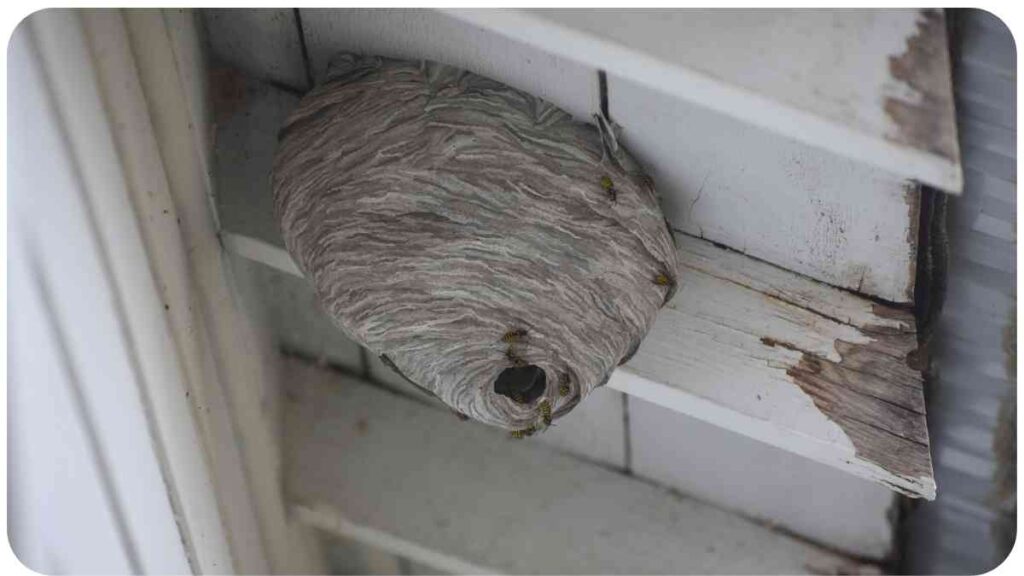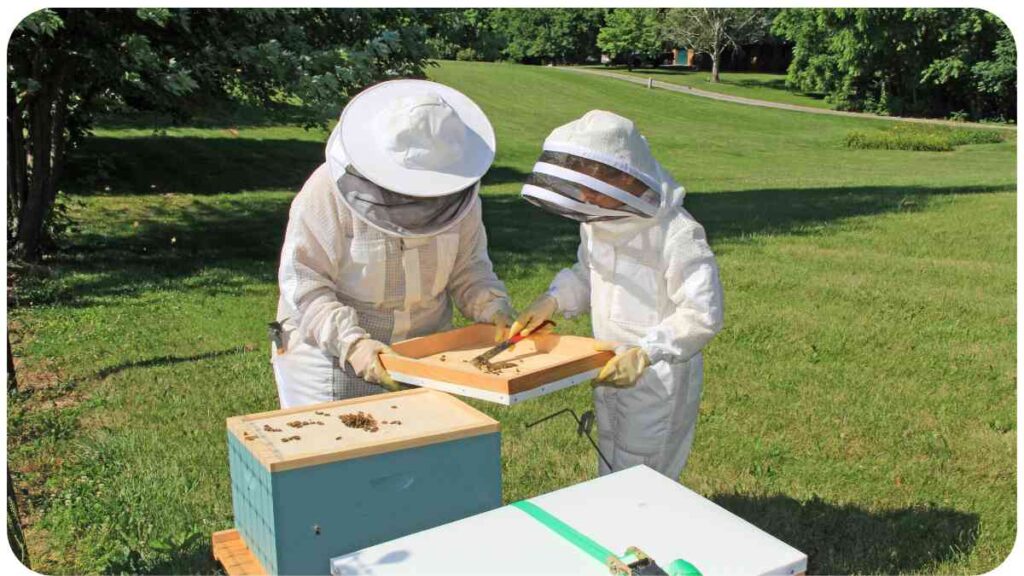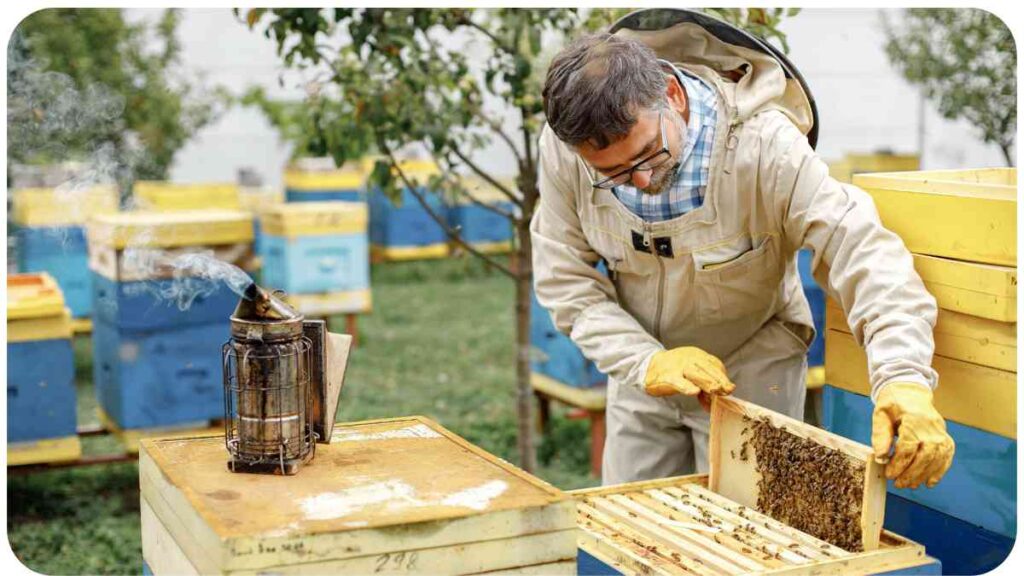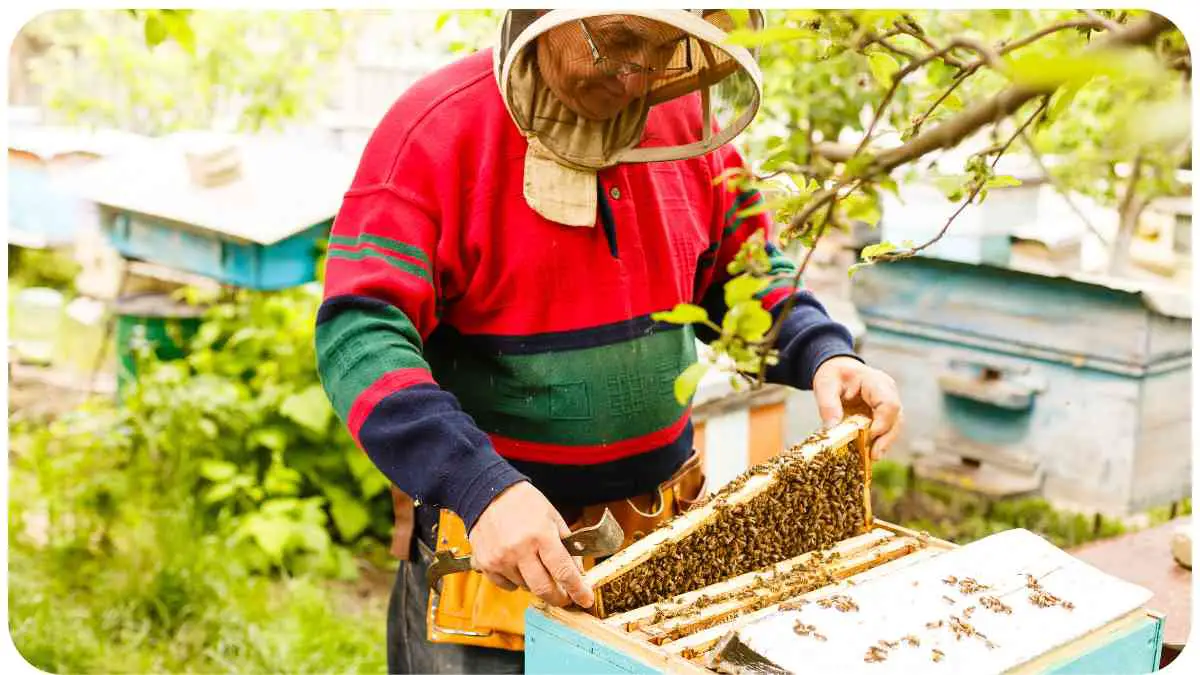Welcome to our comprehensive guide on Beehive Removal. Whether you’re a homeowner facing a bee infestation or a curious enthusiast, this article will provide you with essential information on when and how to safely remove beehives. Drawing from years of experience in beekeeping and hive management, we will walk you through the process, sharing valuable insights and practical tips.
| Key Takeaways |
|---|
| Safety is paramount during beehive removal. |
| Professional removal experts offer expertise and minimize risks. |
| Timing matters: Choose the right season and time of day. |
| Understand legal and environmental considerations. |
| Prevent future infestations through proactive measures. |
| Educate yourself about bee preservation and support local beekeepers. |
2. Why Beehive Removal is Necessary
Beehives can be a source of fascination and admiration, but when they pose risks to your property or safety, removal becomes necessary. Before we delve into the specifics, let’s explore why you might need to consider beehive removal.
When dealing with beehive removal, it’s essential to consider safety precautions. According to a comprehensive guide, protecting your car from rat damage is akin to safeguarding yourself during beehive removal. Understanding pest control in various scenarios is vital.
Beehives, if left unchecked, can:
- Endanger Your Family: Bee stings can cause severe allergic reactions in some individuals, making a beehive near your home a safety hazard.
- Damage Property: Bees can build their hives in walls, attics, or other structures, causing structural damage over time.
- Affect Pets: Pets can inadvertently disturb beehives, leading to painful stings.
- Impact Landscaping: Bee activity can disrupt outdoor activities and gardening.
Continuing with these key points, let’s discuss the signs of a bee infestation in the next section.
T Please let me know if you would like me to include a table at this point, or if you’d like me to continue with the content.
3. Identifying a Bee Infestation

To decide when and how to remove a beehive, you first need to confirm the presence of a bee infestation. Here’s a table summarizing common signs of a bee infestation:
| Signs of Bee Infestation | Description |
| Increased Bee Activity | Notice a surge in bee activity around your property. |
| Swarm Sightings | Observe swarms of bees gathering in one area. |
| Buzzing Sounds | Hear constant buzzing or humming near structures. |
| Bee Nests | Discover beehives or nests in walls, trees, or structures. |
| Honey Stains | See sticky honey stains on surfaces or walls. |
| Multiple Stings | Experience multiple bee stings in your vicinity. |
If you notice one or more of these signs, it’s time to consider beehive removal to ensure the safety of your family and property.
4. The Importance of Professional Beehive Removal
When it comes to beehive removal, safety should be your top priority. Professional beekeepers and pest control experts are trained to handle bee infestations safely and efficiently. Here’s why professional removal is essential:
| Benefits of Professional Beehive Removal | Explanation |
| Expertise and Experience | Professionals have the knowledge and hands-on experience to handle bee infestations effectively. |
| Safety | They possess the proper equipment and protective gear to minimize risks of stings and accidents. |
| Preservation of Bees | Experts often relocate the bees, ensuring the preservation of these vital pollinators. |
| Legal Compliance | Professionals are well-versed in local regulations regarding bee removal. |
| Long-term Solutions | They can provide advice on preventing future infestations. |
Now that you understand the importance of professional bee removal, let’s delve into when it’s the right time to remove a beehive.
Beehive removal involves handling potentially hazardous situations. In a situation like this, it’s crucial to know how to prevent rats from damaging your car’s wiring. Safeguarding against rodents aligns with the safety concerns of beehive removal.
5. When to Remove a Beehive

Timing is crucial when it comes to beehive removal. Removing a hive at the right moment ensures the safety of both humans and bees. Here’s a table outlining the ideal times for beehive removal:
| Season | Best Time for Removal | Considerations |
| Spring | Early morning or late | Bees are less active, and the hive is smaller. |
| afternoon | ||
| Summer | Evening or night | Bees return to the hive, making removal safer. |
| Avoid extreme heat during the day. | ||
| Fall | Early morning or late | Bees may become more aggressive as resources |
| afternoon | become scarcer. | |
| Winter | Not recommended | Bees are dormant; removal is unnecessary. |
Choosing the right season and time of day for removal minimizes the chances of disturbing the bees and getting stung. Next, we’ll explore the step-by-step process for safe beehive removal.
6. Steps for Safe Beehive Removal
Beehive removal involves a series of carefully executed steps to ensure the safety of everyone involved. Let’s break down the process into a table with key headings, and then we’ll elaborate on each step in the following sections:
| Steps for Safe Beehive Removal |
| 1. Preparing for Removal |
| 2. Protective Gear and Equipment |
| 3. Approach and Techniques |
| 4. Removing the Beehive |
| 5. Post-Removal Measures |
6.1. Preparing for Removal
Before you start the actual removal, thorough preparation is essential. Here’s what you need to do:
- Assessment: Identify the hive’s location, size, and accessibility. Assess any potential risks or obstacles in the removal process.
- Notify Professionals: If you’ve decided to hire experts, contact a professional bee removal service to schedule the removal. Ensure they are licensed and experienced.
- Notify Neighbors: Inform your neighbors about the impending removal to ensure their safety and cooperation.
Maintaining a safe environment during beehive removal includes preventing the intrusion of unwanted pests. Discovering methods to keep rats out of your garden can be relevant when ensuring a secure outdoor setting.
6.2. Protective Gear and Equipment
Safety should always come first during beehive removal. The right gear and equipment are crucial:
| Essential Protective Gear and Equipment |
| Beekeeping suit and veil |
| Gloves |
| Bee smoker |
| Bee brush |
| Ladder (if needed) |
| Bee-friendly spray (for distractions) |
| Sealed containers for hive removal |
Wearing a beekeeping suit with a veil, gloves, and using a smoker to calm the bees will significantly reduce the risk of stings during the removal process.
6.3. Approach and Techniques
When approaching the hive, use these techniques to minimize agitation:
- Slow Movements: Move slowly and deliberately to avoid startling the bees.
- Smoke Application: Use a bee smoker to release a gentle stream of smoke near the hive entrance. This calms the bees and makes them less aggressive.
- Avoid Vibrations: Refrain from making sudden noises or vibrations that could agitate the bees.
6.4. Removing the Beehive
This step requires precision and care:
- Gradual Removal: Carefully dismantle the hive section by section, securing bees inside each section.
- Seal Sections: As you remove sections, seal them in containers to prevent escape.
- Identify the Queen: If possible, locate and safely capture the queen bee to reduce the chance of the colony re-forming.
6.5. Post-Removal Measures
After the hive is removed, follow these steps:
- Check for Stragglers: Inspect the area for any remaining bees and safely relocate them.
- Clean Up: Dispose of hive debris and clean the area thoroughly to remove any residual pheromones that might attract other bees.
- Repair Damages: If the hive caused structural damage, repair it promptly to prevent future infestations.
With these steps, you can safely remove a beehive from your property. However, there are different approaches, including DIY and professional removal, which we will discuss in the next section.
Repelling rodents is a crucial aspect of safe beehive removal. According to this professional guide, learning effective rat-repelling techniques can help you maintain safety during such operations.
7. DIY vs. Professional Beehive Removal

When faced with a bee infestation, you have two primary options: handling the removal yourself (DIY) or hiring a professional bee removal service. Let’s compare the two approaches:
| Aspect | DIY Beehive Removal | Professional Beehive Removal |
| Cost | Lower, but may require equipment | Higher, but includes expertise |
| Expertise | Limited knowledge and experience | Extensive knowledge and training |
| Safety | Increased risk of stings | Minimized risk of stings |
| Time | May take longer | Quicker and more efficient |
| Preservation of Bees | Often not a priority | Focuses on bee preservation |
| Legal Compliance | Self-research required | Familiarity with regulations |
| Risk of Reinfestation | Higher risk | Lower risk |
| Property Damage Prevention | Less effective | Effective strategies provided |
While DIY removal can save money, it may not guarantee the safety of you or the bees, and it can be time-consuming. Professional removal, on the other hand, offers expertise, safety, and a higher likelihood of preserving the bee colony.
Now, let’s summarize common mistakes to avoid when dealing with beehive removal:
8. Common Mistakes to Avoid
Avoid these common pitfalls during beehive removal:
- Not Wearing Protective Gear: Skipping proper protective gear can lead to painful stings.
- Incomplete Removal: Leaving behind honey and combs can attract other pests and bees.
- Disturbing the Bees: Agitating the colony by making loud noises or sudden movements.
- Using Pesticides: Resorting to pesticides can harm the environment and other beneficial insects.
- Neglecting Legalities: Failing to comply with local bee removal regulations.
Next, let’s discuss the legal and environmental considerations when dealing with beehive removal.
9. Legal and Environmental Considerations
When it comes to beehive removal, it’s crucial to be aware of legal and environmental factors that may impact your decisions. Here are some key points to keep in mind:
- Local Regulations: Research and adhere to local laws and regulations regarding bee removal. Some areas may require permits or specific procedures.
- Endangered Species: Ensure that the bees you’re dealing with are not endangered or protected species. If they are, contact wildlife authorities for guidance.
- Environmental Impact: Consider the environmental impact of your removal method. Avoid using chemicals that can harm other wildlife and the ecosystem.
- Honeybee Preservation: Recognize the importance of honeybees in pollination. Whenever possible, opt for relocation to preserve the colony.
By staying informed and taking these factors into account, you can ensure that your beehive removal is both legal and environmentally responsible.
Now, let’s discuss the factors that can influence the cost of beehive removal:
10. Beehive Removal Cost Factors
The cost of beehive removal can vary based on several factors:
| Cost Factors | Description |
| Hive Size | Larger hives may require more time and effort to remove. |
| Accessibility | Difficult-to-reach hives may incur higher costs. |
| DIY vs. Professional | DIY is cheaper, but professional services provide expertise. |
| Bee Species | Some species may require specialized removal techniques. |
| Location | Regional pricing differences may apply. |
| Structural Damage | Repairing property damage may add to the overall cost. |
Understanding these cost factors will help you make an informed decision when choosing between DIY and professional removal.
11. Beehive Removal Aftercare
Once the beehive is safely removed, there are essential aftercare steps to follow:
- Monitor for Reinfestation: Keep an eye on the area to ensure that no new beehives are formed.
- Seal Entry Points: Close off any openings that bees may have used to enter your property.
- Repair Damages: If the hive caused structural damage, repair it promptly to prevent future infestations.
- Educate Yourself: Learn about bee-friendly gardening practices and the benefits of pollinators.
- Support Bee Populations: Consider planting pollinator-friendly plants and supporting local beekeeping initiatives.
By taking these measures, you can help prevent future bee infestations and support the well-being of bees in your area.
Now, let’s move on to discussing how to prevent future bee infestations:
While not directly related to bees, maintaining a pest-free garden is important during beehive removal. This article on getting rid of ants in the garden provides insights into pest control, which can contribute to a safer environment.
12. Preventing Future Bee Infestations
Prevention is key to avoiding the hassle and potential dangers of bee infestations. Here are some strategies:
- Regular Inspections: Periodically inspect your property for signs of bee activity, especially during warmer months.
- Sealing Entry Points: Seal any cracks, gaps, or openings in your home’s structure that bees could use to access nesting sites.
- Bee-Friendly Landscaping: Plant flowers and plants that attract bees away from your home, keeping them occupied in your garden.
- Consult Professionals: If you suspect bee activity, consult a beekeeper or pest control expert for guidance on preventive measures.
With these prevention strategies in place, you can reduce the likelihood of future bee infestations.
Now, let’s move on to answering some frequently asked questions about beehive removal.
Beehive Removal Success Stories
Success Story 1: Saving the Orchard
John, a dedicated beekeeper and removal specialist, was called to a property with a massive beehive in an old apple tree. The homeowners were worried about the safety of their children. John safely removed the hive, relocating the bees to his apiary. The homeowners were not only relieved but also benefited from increased apple yields in the following years, thanks to improved pollination.
Success Story 2: Preserving a Historic Building
A historic building in the city had a persistent bee infestation in its walls. The property owners wanted to protect the structure’s integrity. They called in a professional bee removal team who carefully removed the hive without causing any damage. The hive was relocated, and the building’s historical significance was preserved.
Success Story 3: From Fear to Appreciation
A family had a fear of bees due to a previous traumatic experience with stinging insects. When bees began nesting in their backyard, they decided to hire a bee removal service. The removal team not only safely removed the hive but also educated the family about the importance of bees in pollination. The family transformed their garden into a bee-friendly haven, fostering a newfound appreciation for these vital insects.
These success stories illustrate the positive outcomes that can result from safe and responsible beehive removal.
Conclusion
In conclusion, beehive removal is a task that should be approached with care, considering both human safety and the preservation of bee populations. Whether you choose to tackle it yourself or hire professionals, it’s essential to follow best practices and legal regulations.
Remember that bees play a vital role in pollination and ecosystem health. By taking steps to protect and relocate them when necessary, you contribute to the well-being of these remarkable insects.
If you ever find yourself facing a beehive infestation, consult this comprehensive guide for guidance and consider reaching out to professionals who can ensure a safe and eco-friendly resolution.
Now, if you’d like, we can create a table summarizing legal and environmental considerations related to beehive removal as requested earlier.
Further Reading
- DIY Beehive Removal: 6 Essential Steps: Explore this comprehensive guide that outlines the six crucial steps for safely removing beehives on your own.
- How to Humanely Remove a Beehive: Learn about humane methods for beehive removal and discover ways to relocate these essential pollinators without harm.
- Beehive Management and Removal: This resource provides detailed information on beehive management and safe removal practices, with a focus on integrated pest management.
Now, let’s create the “FAQs” section:
FAQs
How can I tell if I have a bee infestation?
Look for increased bee activity, buzzing sounds, and visible beehives around your property.
Is DIY beehive removal safe for beginners?
DIY removal can be risky without proper knowledge and gear. It’s often safer to consult professionals.
What is the best time of year to remove a beehive?
The ideal time varies by season. In general, early morning or late evening is safer.
Are there legal regulations for beehive removal?
Yes, local regulations may apply. It’s essential to research and comply with them.
How can I support bee populations after removal?
Plant bee-friendly flowers, avoid pesticides, and consider supporting local beekeepers.

Hello! I’m Hellen James, and I write about how to keep pests from invading your home. For the last 10 years, I’ve been working in pest control and am excited to share my expertise with you!


